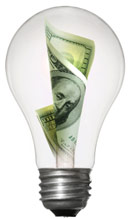
Call: 608•637•6196
Email: wayne@greenfoamit.com
BioBased Videos

BioBased Insulation Application (4:37)
Shows BioBased Insulation being installed in a home from start to finish. Sprays in as a liquid and quickly expands to multiple times in size to seal and insulate in one step.
YouTube Channel
Check out BioBased's YouTube Channel
You will find a variety of videos that feature BioBased Insulation as well as clips of shows that have featured BioBased Insulation in the past.
Contact us today!

Call us and we will be glad to set up an appointment to discuss the advantages of foam based insulation products.
Tax Benefits

There are currently several programs that offer tax credits to "green" your home. BioBased® insulations qualify for such credit.
For improvements made through the taxable year of 2010, homeowners will need the following paperwork attached to their tax return:
- IRS Tax Form 5695 (2009 version)
- A Manufacturers' Certification Statement
Your accountant will be able to provide you with the specific details of the tax credit for your home state.
For the most up-to-date information for state tax credits, visit the Database of State Incentives for Renewables & Efficiency or use the following links:
For an overview of Federal tax credits, visit EnergyStar.gov.
Tax Credit FAQ
1. How many tax credits are there?
There are two tax credits and a tax deduction. There is a tax credit for builders on new construction, a tax credit for homeowners who make energy efficient upgrades to their existing homes, and a tax deduction for commercial property owners who reduce energy consumption of their buildings.
2. How does a builder get the new construction tax credit?
A builder must design the house to be 50% more efficient than a model IECC home. You can use numerous approved computer software to accomplish this. You must then build the home to those specifications and have an energy rater come out and do a performance test on the house.
3. How does foam insulation fit into the new construction tax credit?
The tax credit requires that 1/5 of the efficiency come from building envelope components.
4. Do I have to turn in new paperwork to the IRS to qualify for either of the two tax credits?
Yes, IRS Form 8908. You must also keep your receipts and your documentation that your home meets the standards.
5. What is the new construction tax credit?
Home builders are eligible for a $2,000 tax credit for a new energy efficient home that achieves 50 percent energy savings for heating and cooling over the 2004 International Energy Conservation Code (IECC) and supplements. At least 1/5 of the energy savings must come from building envelope improvements. These tax credits apply to new homes whose construction is substantially completed after January 1, 2006 and that are acquired from the eligible contractor after January 1, 2006 and before December 31, 2009, for use as a residence.
You don't receive an income tax credit when you buy the product, like an instant rebate. You claim the credit on your federal income tax form at the end of the year. The credit then increases the tax refund you receive or decreases the amount you have to pay.
7. Tax credits vs. tax deductions
In general, a tax credit is more valuable than a similar tax deduction. A tax credit reduces the tax you pay, dollar-for-dollar. Tax deductions — such as those for home mortgages and charitable giving — lower your taxable income. If you are in the highest 35-percent tax bracket, the income tax you pay is reduced by 35 percent of the value of a tax deduction. But a tax credit reduces your federal income tax by 100 percent of the amount of the credit.
8. What energy-efficient home improvements are eligible for existing homes?
The overall $500 cap can be reached in several ways with the purchase and installation of energy-efficient products:
- Exterior windows: 10 percent of the total cost, up to $200. Includes skylights and storm windows.
- Insulation, exterior doors, or pigmented metal roofs: 10 percent of the cost of the product (but not the installation), up to $500. Includes seals to limit air infiltration, such as caulk, weather stripping, and foam sealants, as well as storm doors.
- Central air conditioner, heat pump, or water heater: up to $300 towards the full purchase price, including installation costs.
- Furnace or boiler: up to $150 towards the full purchase price, and/or $50 for an efficient air-circulating fan in a furnace, including installation cost.
VIROQUA, Wis. (March 30) — Buying or building a new home is not the only way to qualify for the government's recent tax incentive programs. Expanded provisions in existing programs now make it possible for homeowners to earn up to $1,500 in tax credits for energy-efficient improvements.
Homeowners who make qualified improvements including windows, doors, insulation, heating and cooling equipment, water heaters and stoves to their home are eligible for a tax credit equal to 30 percent of the amount paid by the taxpayer up to $1,500. The incentive is actually an expansion of a previous program that was capped at a 10 percent credit and $500.
For insulation to qualify, its primary purpose must be to insulate. The insulation must also be expected to last five years or have a two-year warranty. BioBased Insulation® is one product that will help homeowners qualify for the tax incentive.
BioBased Insulation® is a soy-based spray polyurethane foam insulation. It installs as a liquid that expands to fill stud-to-stud and creates an air barrier. That air barrier drastically reduces air and moisture movement within a home which increases the energy efficiency and the comfort of the structure. BioBased Insulation does not sag or settle over time and comes with a lifetime warranty.
BioBased Insulation® can be installed in attics and crawlspaces — typical problem areas in existing homes — by certified dealers who are trained in building science and application. The tax credit does not include installation costs, only product costs.
These are tax credits, which require the homeowner to spend money before receiving the credit, but tax credits will lower your tax bill dollar-for-dollar.
To qualify for the program, all improvements must be made in 2009 and 2010. Before making improvements, it is a good idea to consult a certified public accountant to make sure your improvements qualify. To claim the credit for insulation, homeowners need a copy of their receipt and should use IRS Tax Form 5695 (version 2009). BioBased Insulation® has provided a manufacturer's certification statement on our Web site that can also be included.
Courtesy of www.biobased.net
Disclaimer: Green Foam LLC is not an expert in tax credits or tax returns. The information on this page is gathered from other websites and provided to you as a courtesy. Therefore, we cannot guarantee the complete accuracy of the information provided. Please direct any tax questions to a certified public accountant.






